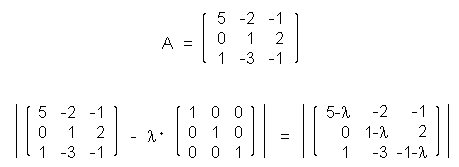| VIAS Encyclopedia provides a collection of tables and definitions commonly needed in science and engineering. |

|

Home  Mathematics Mathematics  Matrix Algebra Matrix Algebra  Eigenvectors and Eigenvalues Eigenvectors and Eigenvalues |
|||||
| See also: Matrix Determinant | |||||






|
|||||
Eigenvectors and Eigenvalues
|
|||||
|
Characteristic
Determinant
Characteristic Function |
For a given matrix A, |A -λ I|
denotes its characteristic determinant in the unknown λ.
The polynomial function χ(t) := |A - λ I|
denotes its characteristic determinant in the unknown λ.
The polynomial function χ(t) := |A - λ I| is called the characteristic function of A. This implies that the determinant is expanded. I| is called the characteristic function of A. This implies that the determinant is expanded. |
Example: Characteristic Determinant

Finally, eigenvectors and eigenvalues are defined as a solution of the
characteristic function:
| Eigenvalue, Eigenvector | For a given matrix A and its characteristic function χ(t) = |A -λ I|,
the roots of the characteristic equation χ(t) = 0 are called eigenvalues (or characteristical roots) λ1, λ2, ..., λk. They meet the criterion
A I|,
the roots of the characteristic equation χ(t) = 0 are called eigenvalues (or characteristical roots) λ1, λ2, ..., λk. They meet the criterion
A e
= λj e
= λj |
This text is part of "Teach/Me Data Analysis" and has been included by permission of the author.
 Mathematics
Mathematics  Matrix Algebra
Matrix Algebra  Eigenvectors and Eigenvalues
Eigenvectors and Eigenvalues
Last Update: 2010-12-14

